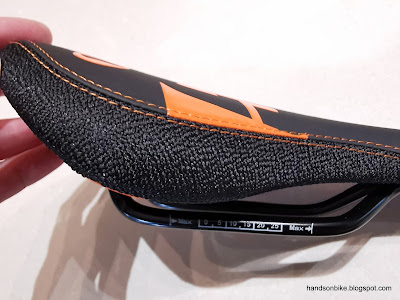The
Bestrider Pump Pro 16 kids bike came with a decent small saddle for kids, but the
lack of adjustability is a problem. Only the saddle height can be adjusted via the seatpost height, while the saddle fore/aft and tilt cannot be adjusted at all. This is because the saddle attaches to the seat post via a pipe-fitting interface (refer to pictures below), instead of using the common saddle rail interface.
Another issue was that this pipe-fitting interface had looseness between the saddle and the seat post which could not be eliminated. To be honest, this kind of interface is not good at all, and only used because it is cheap.
Therefore, to optimize the saddle position for proper riding, I decided to get a new kids-specific saddle for this bike. As the stock seat post does not have a clamp for saddle rails, I also had to get a new seat post at the same time.
I found that it was nearly impossible to get a decent kids saddle that is not too big or with overly-thick cushion. There are very few options available.
Finally I found a source which had this SDG Fly Junior saddle that is highly rated for kids. There was practically no second option for a good quality kids saddle.
SDG Fly Junior kids saddle!
Some of the features of this saddle.
Standard saddle construction with normal saddle rails.
Tough side material to prevent scuffing when the bike is rested against the ground or wall.
Comparing it to a standard adult road saddle.
Although it is shorter than the adult saddle, it can actually be even shorter and will still be fine.
Narrower to suit the kids' narrower sit bones. You will be surprised how many kids saddles are too wide.
Comparing the shape of the stock saddle (on the left) with the new saddle. Original saddle is even shorter.
Stock saddle has a large plastic bottom shell which matches with the stock seat post. This is what I meant by pipe-fitting interface.
Stock saddle has a cutout at the rear of the saddle, for an adult to hold the saddle using fingers when guiding the kid on the bike.
Stock saddle is chunkier as well, with a very thick and soft cushion.
As for the seat post, a standard 27.2 mm diameter seat post is needed. Since I
already had the carbon handlebars, I might as well get a carbon seat post as well. There are many available online, but I decided to get one from Toseek which is of better quality. I'm not too concerned about the strength of these carbon seat posts, because it will only need to take a kid's weight and not an adult. Also, as long as you don't get the super lightweight type, the strength is usually more than sufficient as they will just use more carbon to ensure sufficient strength. The risk comes when you buy lightweight carbon parts from unknown sources.
New carbon seat post! Definitely needs to be cut to fit the kids bike frame.
Dual bolt top and bottom clamp, pretty standard stuff. However, the resting surface for the saddle rails is rather short as it is limited to the centre portion.
Standard bolt and clamp interface, similar to Litepro seatposts.
There is actually an open slot at one of the clamping areas, which is not such an ideal design. I did not notice this when I ordered the seat post.
Wall thickness is equal around the circumference, and more than thick enough.
Weighs 221 grams, which is decent but not really lightweight for a carbon seat post. That's perfectly fine as I don't need to worry about insufficient strength.
After measuring and cutting off almost 90 mm of seat post...
...the seat post weight is now reduced to 194 grams which is great.
New SDG Fly Junior saddle is 260 grams which is so-so. I expected it to be lighter as it is smaller than the usual adult saddles.
New saddle plus new seat post weighs 454 grams.
Stock seat post and saddle only weighs 254 grams! That is really very lightweight.
A lot of the seat post weight comes from the saddle clamp area, not the aluminium or carbon tube. Also, the steel saddle rails on the saddle accounts for a lot of the saddle weight as well. The stock seat post and saddle design eliminates both of these heavy components, which allowed it to save a lot of weight. However, this sacrifices the option of saddle adjustability.
New saddle and seat post installed on the upgraded 3 speed kids bike! Unfortunately the orange saddle does not really match the red frame.
Finally we can adjust the saddle tilt angle...
...and also the fore/aft setting to optimize the pedaling ergonomics.
Overall, this seat post and saddle upgrade actually caused a 200 grams increase in weight, which is unusual. The better saddle quality and position adjustment comes at a cost of heavier weight.
Bestrider Pump Pro 16 (Single Speed)
5.6 kg without pedals and kickstand, in stock condition.
About 6 kg with larger Early Rider pedals (266 g) and kickstand (102 g).
Bestrider Pump Pro 16 (3 Speed)
After upgrading to 3 speed drivetrain, new SDG saddle and seat post.
- 6.6 kg without pedals and kickstand.
- 7.0 kg with Early Rider pedals (266 g) and kickstand (102 g).
At 7.0 kg for a 3 speed kids bike, I think it is a very good weight. Probably very difficult to go any lower unless you change to carbon wheels or carbon frame/fork.





















































